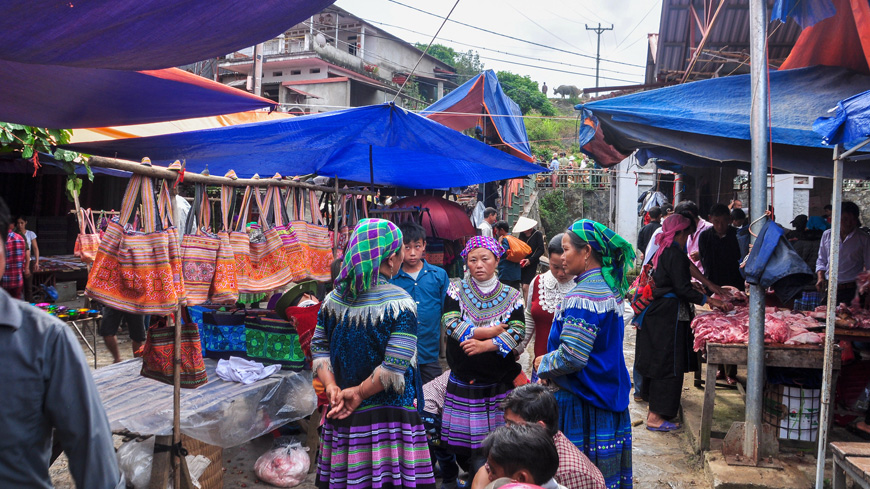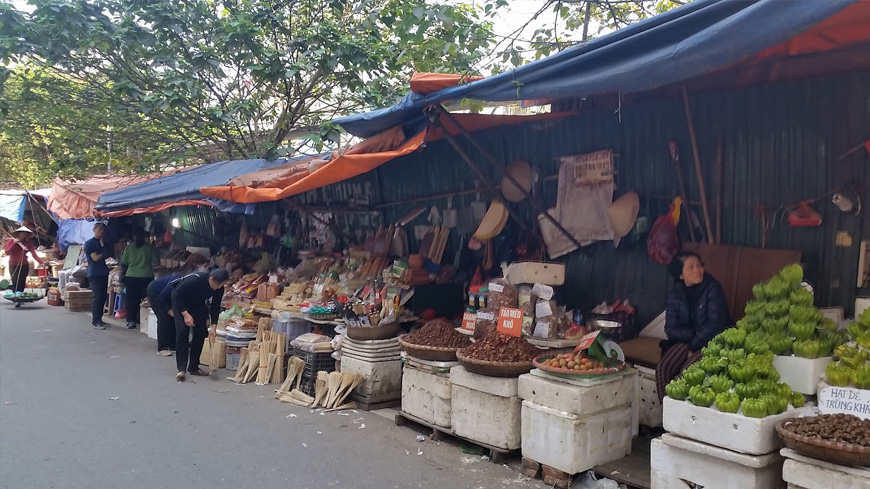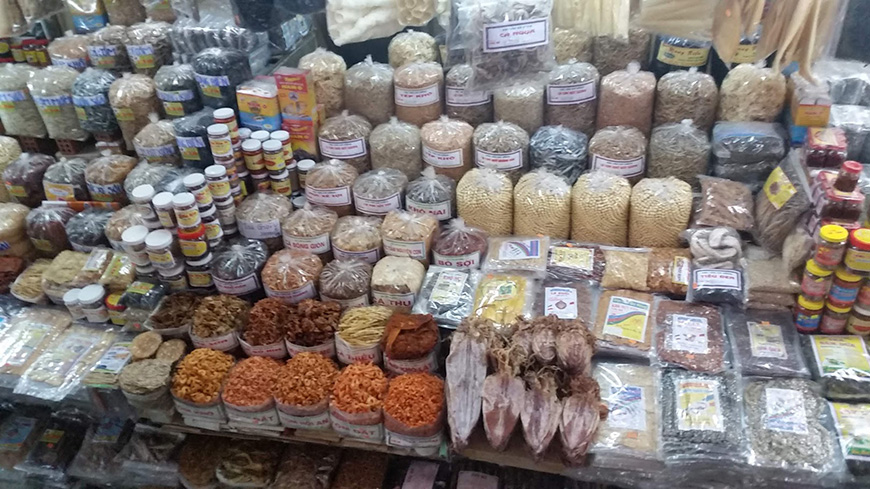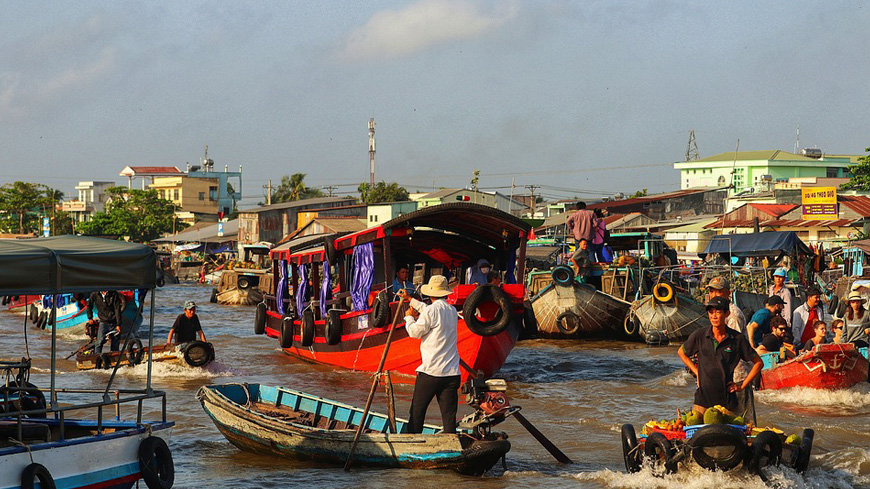Vietnam is a country rich in culture and traditions. One of the most immersive ways to discover its unique culture is to stroll through local markets, not only for a unique shopping experience, but also for authentic encounters and sharing.

Ethnic Market in Northern Vietnam - Picture Mr Linh's Adventures
Shopping in a local Vietnamese market – Introduction
Whatever the country, shopping in local markets is always the best way to immerse yourself in a foreign culture and Vietnam is no exception to the rule. Food, souvenirs, clothing and above all much more than trade, Vietnam’s local markets offer a multi-faceted vision of a unique way of life.
Markets have existed since the dawn of humanity, all over the world. And if they are of course places of trade, they have kept – especially in Asia and particularly in Vietnam – this essential function of creating social ties through exchanges and gathering. A millennial practice, the market is part of the collective unconscious of the Vietnamese, shaping a unique cultural heritage, which is declined according to geographies, topographies and regional weather. Urban market, country market, landlocked market of local mountain communities or floating market, all the kind of market in Vietnam reflect the cultural diversity of its ethnic communities.
When we talk about local markets, we immediately think of ethnic markets and their exoticism. But this spirit of sharing, of exchange, this particular web on which privileged links are forged is also found in urban markets. We are here far from the modern temples of consumption discussed in another article. The human is here still present, the smiles are and the art of negotiation still has its place.
3 reasons to stroll between the stalls of a local market
1-Live a unique cultural experience
Visiting a market in Vietnam is entering the daily life of the inhabitants. It is to meet people from all walks of life, from the onlooker to the saleswoman, through the housewife who negotiates her purchase. It is to discover products all more exotic than the others, it is to be imprinted with noises, colors and smells in a change of scenery that will be found even on the catering stand.

Around Dong Xuan Market, Ha Noi - Picture Mr Linh's Adventures Team
2-Find real local products
Without neglecting the probability of finding Made in China, it will still be easier to find in a local market enough to make good deals. On the other hand, it is necessary to know how to negotiate or to be helped by someone who masters the art and the way to make fall the prices but not the face. The mountain markets are particularly picturesque. Only there – or almost – you will find authentic Hmong or Dao fabrics, to speak only of the best known.
3-Enjoy an incomparable street food
In the urban markets but also country, let yourself be tempted by the correstaurant area. If you are an adventurer of taste, a bold taste buds or simply curious and greedy (not necessarily in this order), you will find on the markets what no restaurant will offer you. But expect unlikely rustic, bewildering creativity and incredible flavours.
What are the types of local markets in Vietnam?
1-Urban local markets
It is obvious that there is no reference here to supermarkets or even supermarkets, but to modest street markets, neighborhood markets or even wholesale markets.
Usually opened at dawn, they provide food for the day. Ephemeral, they can stand along a street, on a sidewalk or come alive under the cover of a roof, a legacy of French colonization. The most famous covered markets are Dong Xuan in Hanoi and Ben Thanh in Saigon. In this category of markets, we will also see flower or fish markets (Hoi An is particularly famous).
.jpg)
Dong Xuan Market, Hanoi - Picture Mr Linh's Adventures Team
The urban markets of Hanoi
Cho Dong Xuan
Built in the late 1880s, the covered market of Dong Xuan once occupied the banks of the To Lich River. It will then be installed Dong Xuan district, during 1889.
Intimately associated with the history of the capital and the country, it represents not only a lively wholesale market, but also many historical and cultural values. You will find everything from many provinces of Vietnam, from silk to food, to souvenirs for tourists. The restaurant area is worth a visit (as well as the adjacent streets, for curious gourmets…).
The weekend’s night market
Rather commercial and tourist destination, the night market of the weekend in Hanoi remains however a place and a friendly atmosphere to experiment. For 3 km, between Hang Dao and Cho Dong Xuan, Hang Ngang, Hang Dao and Hang Duong streets host nearly 4,000 stalls, in a riot of clothes, toys, crafts and food. A good point: the prices are relatively cheap.
But also: Quang Ba, the flower market, Cho Hom, specialized in fabric, Long Bien, huge night market wholesale and detail for fruits and vegetables.
The urban markets of Ho Chi Minh City
Cho Ben Thanh
An emblematic figure of ancient Saigon, Ben Thanh was founded by the French along the Ben Nghe River. In the 1911’s, the colonial government decided to move it to its present location. The construction will be spread from 19152 to 1914.
Operating almost the same way today, it hosts nearly 1,450 stalls and close to 6,000 small merchants. Here too, you will find all kinds of products, from food to high-end products.
Cho Binh Tay (Cho Lon)
Located in District 6, in the heart of Chinatown, Cho Lon is one of Saigon’s historic old districts. In a very local atmosphere installed in remarkable colonial buildings, we like to travel in the trip, discovering the turn of each stall, clothes, bags, makeup, linens, toys and other motorcycle helmets. You must absolutely test the street food on the ground floor!
But also: Russian Market, for Russian customers, Cho An Dong, for wholesale and retail of textiles…
Not to mention Dang Ba, in Hue or the very warm night market of Hoi An.

Market Stall, Da Nang city - Picture Mr Linh's Adventures Team
2-Country markets
Traditionally installed at the gates of villages, in the shade of a banyan tree often several hundred years old, they are usually sheltered in a small hall covered with old tiles.
Dedicated to the daily needs of the local population, they are important and indispensable points of economic, cultural and social encounter. They trade, bargain, chat and drink. Some cherish the secret hope of meeting the one with whom to found a home…
While it is less crowded than its urban cousin, “Cho Que”, the country market, offers seasonal and local products from early morning to around noon.
Note that there are two types of country market: fairs and night markets (Cho Hom). The particularity of the fairs is that they are held periodically, for example the days ending with a 3 or an 8, that is, the day 3, 8, 13, 18, 23 and 28 of the lunar month. For some time, the biggest fairs are also held on Sundays. Less crowded and less busy, the Cho Hom can start the afternoon under the name of Cho Chieu, to continue at night.
.jpg)
Bac Ha Market - Picture Mr Linh's Adventures
3-Markets of mountain ethnic groups
Certainly the most spectacular and captivating.
Generally landlocked in the remote and steep regions of North Vietnam, ethnic markets summon local communities for moments of conviviality and exchange, then trade and negotiations. Because in these regions fragmented by the valleys, lost between rocky cliffs and vertiginous passes, the day of the market is the unique and privileged moment to peddle besides the agricultural tools, the last rumors and gossip of the moment. In the shimmering froufrou of the traditional costumes of each community, we talk, laugh, share, have fun. It sometimes took us several days to get there, so we take the time to play the flute, dance and sing. And incidentally, to do a little trade... An indispensable place of sociability, one may find there the woman of his life. One will certainly find those with whom to share a few cups of rice alcohol.
Here too, the traveler is advised to take a tour of the food stand to discover a cuisine certainly rustic and bold, fearlessly creative in its opportunism to eat everything, but always delicious and tasty.
Be aware that ethnic markets are held weekly, often on Sundays like the markets of Bac Ha or Meo Vac. Some follow the lunar calendar as the market of Bao Lac in the Northeast of Vietnam.

Floatting Market - Picture Pixabay
4-Floating markets
Icons of the Mekong Delta, floating markets (Cho Noi) take place on the side branches of the mythical river, according to an atypical and fascinating way of life.
As on land, the floating wholesale market (Long Xuyen, for example) will be distinguished from the floating retail market (Nga Nam, the colorful one). Mainly dedicated to the sale of fruits and vegetables, the boats announce their products by hanging them at the end of a long pole that will be posted at the bow. The show of the ballet of boats, big as small, where exotic fruits and vegetables of the land are exchanged is an exotic and vibrant enchantment, but which requires to get up (very) early, in general, the animation falls before 9 am. In this atypical way of life, are bought and sold rambutans, oranges, grapefruit, mangosteen, durians or freshwater fish, snakes, crabs or other shrimp, while some boats are dedicated to catering, coffee, or even the sale of household and electronic items.
Although less lavish than Thailand’s floating markets, the largest and oldest in the Mekong Delta are Nga Bay, Phong Dien or Cai Rang (Can Tho City), Phung Hiep (Hau Giang Province), and Cai Be (Tien Giang Province). Most agricultural products and fruits are sold to wholesalers, who then resell them to factories for processing or send them to Hanoi and the Northern Provinces.
Cho Noi Cai Rang (Can Tho)
Made popular by its location and easy accessibility, Cai Rang is considered the largest floating market in the Mekong Delta.
Nowhere else can we find the hustle and bustle that reigns in this emblematic market of an atypical lifestyle more than 100 years old. It is known for its trade of typical fruits of the region, such as the grapefruit of Nam Roi, the kiwi of Vinh Long or the durian of Cai Mon.
Cho Noi Cai Be (Tien Giang)
Located near Ho Chi Minh City, this busy market is considered a major transportation hub and trade of agricultural products of the South Delta with the rest of the country.
In addition, it remains open a little late than the others, to the delight of travelers a little late.
Cho Noi Long Xuyen (An Giang)
One of the least known and therefore less frequented by foreign travelers.
In addition to fruits and vegetables, Long Xuyen is renowned for its cuisine (which is not to be called street-food…), simple, authentic and generous. A hidden jewel of the Mekong Delta, with an authentic and intimate atmosphere